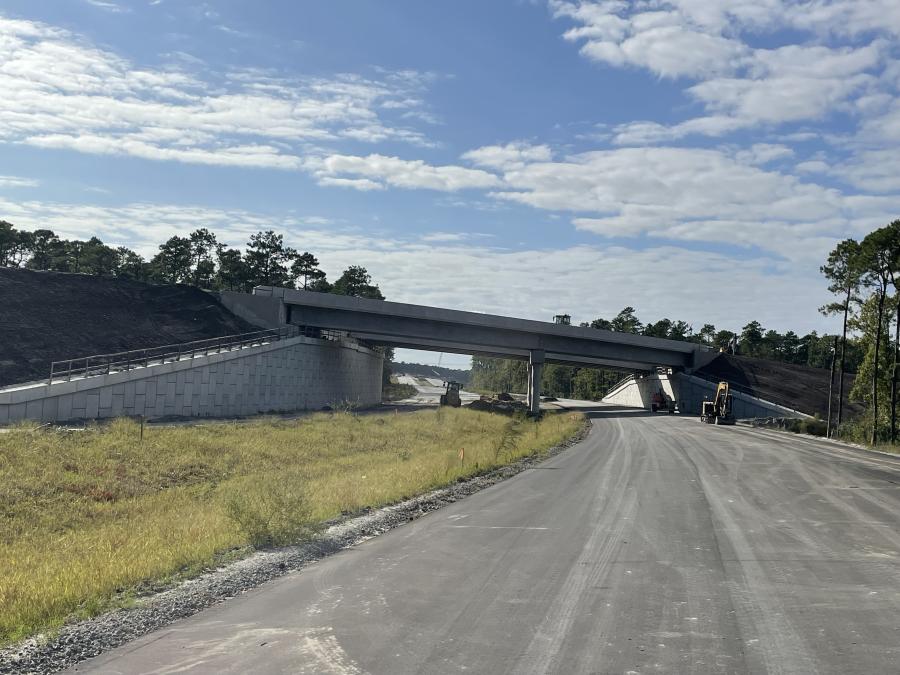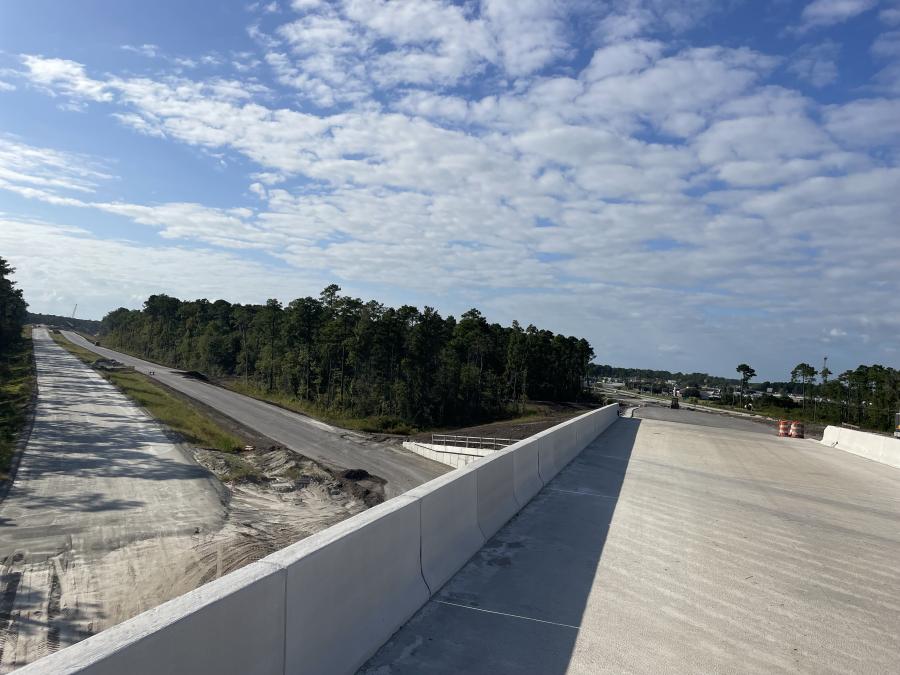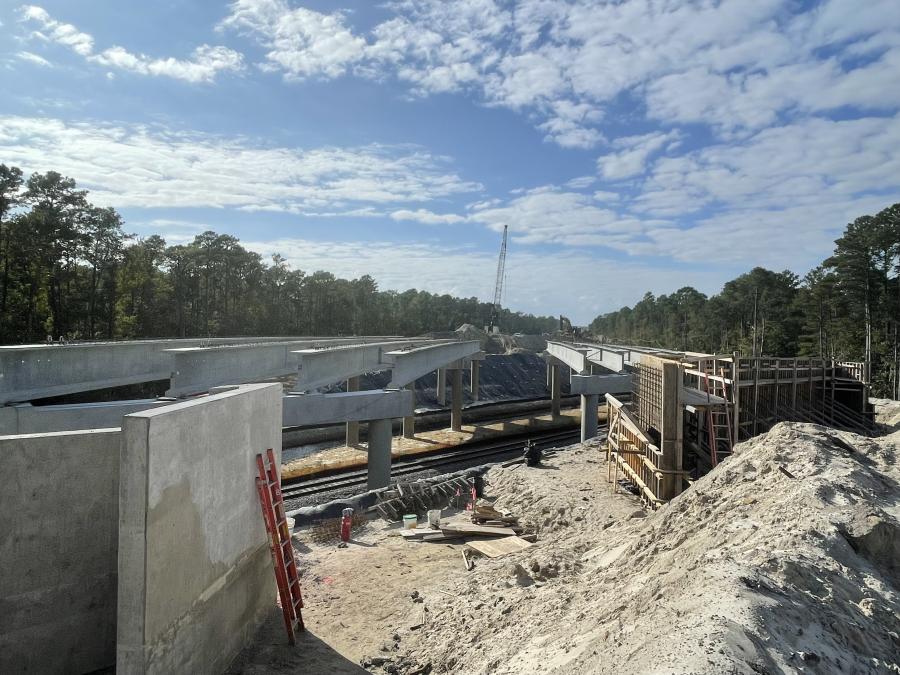Photo courtesy of NCDOT
At the Havelock Bypass, Balfour Beatty has so far constructed 16 new bridges, and raised two existing overpasses across the new highway.
A relatively short but critical bypass of U.S. Highway 70 around the small community of Havelock, in southeastern North Carolina, is now in its last year of construction after the state's Department of Transportation (NCDOT) commissioned the project in 2019.
When complete, the new freeway will be designated as a section of the state's future Interstate 42.
That was the word from Brad McMannen, NCDOT's resident engineer on the U.S. 70/Havelock Bypass, in late September when he was asked to give an update on the project.
He said the new 10.3-mi., four-lane divided highway, designed to divert traffic to the west side of the small town and encompass parts of Craven and Carteret counties, has progressed to the point that he felt confident in saying construction crews are likely to have the job finished late next summer — only a few months longer than his agency anticipated in 2014.

Photo courtesy of NCDOT
"A lot of that delay is because of the interchange at the north end of Havelock where U.S. 70 meets U.S. 70 Business," he explained. "We had to hold up the construction until we got a redesign on that part of the project."
Originally, the interchange was planned so that traffic would travel at 60 mph, but an upcoming project that ties into the bypass has a speed limit of 70 mph.
"With the bypass and that new project each having higher speed limits than the interchange, we needed a redesign to make it 70 mph throughout, meaning we also had to change some walls, and do a little bit of structure and field work," McMannen said.
The change also boosted the overall price tag of the bypass. McMannen declined to name a cost figure for the redesign, but NCDOT currently lists the construction at $167.2 million.
Factoring in the costs for the project's development, design, right-of-way acquisition and utility relocation, the grand total to build the Havelock Bypass is $221.25 million, the agency noted on its website.
Balfour Beatty Infrastructure in Wilmington, N.C., has managed crews to build the project since the effort began at Havelock nine years ago.
Havelock Bypass One of Nine Upgrades
The Havelock Bypass is one component of NCDOT's plan to upgrade the high priority U.S. 70 corridor to eventually become I-42 in eastern North Carolina between Raleigh and the Port of Morehead City on the Atlantic coast, a drive that currently takes a little less than three hours. Most of the roadway already accommodates four lanes of traffic.
Nine different projects make up the transportation agency's plan to improve the route, most of which are either under construction or still in development. They include additional bypasses around the cities of Goldsboro and Kinston, and upgrades to the highway through the town of James City, just south of New Bern.
Connecting with the Havelock Bypass on its north end is a $242 million U.S. 70 upgrade that will start construction next year and continue northwest for 6.4 mi. to near Thurmond Road, where it will join the James City portion of the corridor. NCDOT projects that building effort to last about four years.
"Balfour Beatty Infrastructure will work on that part of the roadway as a design-build," McMannen said. "They are continuing to work out the rights of way, the utilities and finalize the plans. Also, the Kinston Bypass west of here is one that is still in the design phase, while the Goldsboro Bypass has been completed, so there are different legs still being built and others undergoing their initial designs."
Although much of the area is rural and more sparsely populated compared to points west and north, U.S. 70 in the Tarheel State's eastern third is a key route for moving freight to and from the Port of Morehead City and plays an important role in evacuating people from the state's beaches ahead of summertime hurricanes.
Additionally, two key East Coast military bases are just off U.S. 70 — the Marine Corps Air Station Cherry Point on Havelock's east side, and Seymour Johnson Air Force base in Goldsboro.
Construction Effort Has Seen Little Slowdown
At the Havelock Bypass, Balfour Beatty has so far constructed 16 new bridges, and raised two existing overpasses across the new highway. No bridge or structure demolition was needed on the job, according to McMannen.
In addition, Balfour Beatty is overseeing the work of a number of key subcontractors on the U.S. 70 bypass, including Barnhill Contracting Co., to handle asphalt work; Bullington Construction Inc., in charge of installing guardrails; Gosalia Concrete Constructors, builders of the concrete barrier rails; National Erectors, rebar and steel professionals; and four companies that hauled in stone, riprap, aggregate base stone (ABC), and asphalt to the job site: Military Federal Construction, More Tons LLC, M&J Trucking Inc., and RL Thompson Inc.
McMannen said that most of the borrowed hauling on the bypass has been done by Balfour Beatty with off-road trucks. He added that all but one pit is on the new road alignment where the subs used on-road trucks – the other pits required off-road vehicles.
With much of the Havelock construction site being in a part of the state where wetlands are prevalent, excavation was required to remove less desirable undercut material to allow for aggregates to be trucked in to give the new roadway a more stable base, he added.
"We have had 95,000 cubic yards of undercut excavated, then replaced by borrow from the pits that totaled 4.9 million cubic yards, and we still have some left to bring in for various tie-ins," said McMannen. "We are still scheduled to get close to 5.8 million cubic yards of material before the work is done."
The result will provide the Havelock Bypass better drainage and a more solid support for the highway's pavement.
Although the construction's completion late next summer is in sight, McMannen said much work still needs to be accomplished to build a bypass that meets federal interstate standards.

Photo courtesy of NCDOT
"We are working on the interchanges — the bridges on both ends of the project," he said. "The next step is to detour traffic onto the bypass at the interchange with U.S. 70 that continues into Havelock on the north end of town. We also will continue to build the tie-ins and construct bridges and road surfaces, even though a lot of the work is completed.
"In addition, the contractors are still bringing in a lot of ABC stone to get the roadway covered up and get it paved to help with drainage and erosion control measures, and we have most of our pipe work completed too. At this point in the project, there are just a variety of things that still need to be done."
McMannen could not think of too many days since the effort began when the work has slowed down at the Havelock site.
"It has been fairly busy from the get-go and stayed consistent throughout most of the project," he said. "It is a great operation because we are still hauling, as I said, and the structural crews will work on a couple bridges at a time and then move on to another one. Plus, when we have one subcontractor finish a component of the job, another sub comes in to perform their task. That keeps things buzzing on site. In a single month, we will have 125 to 150 different people out here working."
That also holds true during southeastern North Carolina's generally mild winters, McMannen added, as the weather is usually kind to road construction crews on site and allows them extra time to get their jobs completed.
"The only thing that slows us down during those months is applying asphalt to the road, work which is based on the temperatures," he noted. "If we can get temperatures of 45-50 degrees or higher, we can continue to pave."
As far as pouring concrete, McMannen said, "Typically, we think of 35 degrees as the lowest temperature during which to lay concrete. Down here, we don't see temperatures that low any longer than a day or two. We just have to make sure that when we pour, if the temperatures drop below 45 degrees, we keep the concrete covered with blankets to keep it heated so it can properly cure."
Thoughtful Planning
Partly due to the planned construction of the U.S. 70/Havelock Bypass within the environmentally sensitive Croatan National Forest, NCDOT had its choice of three different alignments on which to build the roadway, McMannen said.
The state transportation agency ended up preferring Alternative 3, NCDOT noted on its website, because the plan:
- provides the best balance of minimizing impacts to natural and human environmental resources, the Croatan National Forest and the city of Havelock.
- is the least costly alternative.
- has a small number of relocations.
- minimizes habitat fragmentation effects.
- is conducive to prescribed burning, which allows the U.S. Forest Service to manage essential habitats.
- has the least amount of stream impacts.
- has a "middle ground" impact to prime farmlands and riparian buffers as compared to the other two alternatives. It also balances slightly higher impacts to these resources against the greater effect to the Croatan Forest and endangered species associated with Alternative 1.
McMannen noted that due to the presence of endangered species within the national forest, such as the red-cockaded woodpecker, the Havelock Bypass construction team had to minimize the clearing operations as much as possible and reduce their footprint in the freeway's right of way.
"We have a monthly meeting with the environmental agencies where they go through the project and help us evaluate our restoral measures in the wetlands, and part of the permit was maintaining the woodpeckers' zone as much as possible," he said.
When the Havelock Bypass is finally finished and ready for drivers in 2024, McMannen said it will await its connection to the other I-70 Corridor projects when they are completed in the coming years. With several of them still in the development and design phase, he knows that time will not come soon, but he looks forward to seeing the finished product. CEG
Eric Olson
A writer and contributing editor for CEG since 2008, Eric Olson has worked in the business for more than 40 years.
Olson grew up in the small town of Lenoir, NC in the foothills of the Blue Ridge Mountains, where he began covering sports for the local newspaper at age 18. He continued to do that for several other dailies in the area while in college at Appalachian State University. Following his graduation, he moved on to gain experience at two other publications before becoming a real estate and special features writer and editor at the Winston-Salem Journal for 10 years. Since 1999 he has worked as a corporate media liaison and freelance writer, in addition to his time at CEG.
He and his wife, Tara, have been married for 33 years and are the parents of two grown and successful daughters. His hobbies include collecting history books, watching his beloved Green Bay Packers and caring for his three dogs and one cat.
Read more from Eric Olson here.
Today's top stories

















